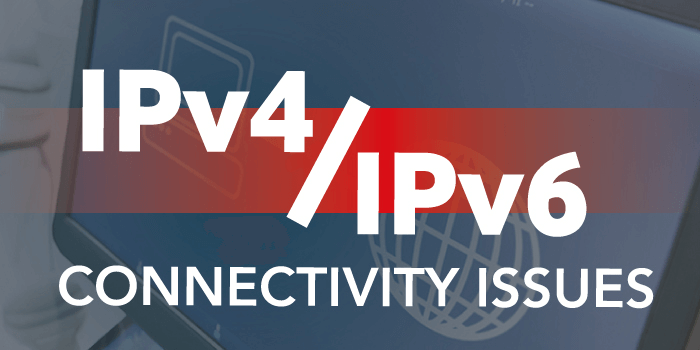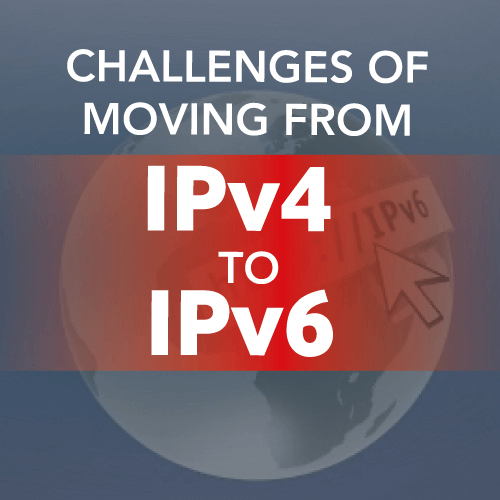![]()

March 30, 2023
IPv4 / IPv6 connectivity issues | No internet access “Fix them”
Having IPv4 / IPv6 connectivity issues can be very annoying especially if it happens more frequently than it should be.
That’s why, in this blog post, we will discuss a step by step guide to help you through solving the connection errors.
What is IPv4 Connectivity and IPv6 Connectivity?
To understand how to solve IPv4 / IPv6 connectivity issues , you need to know what their connectivity means first. IPv4 and IPv6 connectivity is a term which refers to the ability of a device or network to connect to the Internet using the internet protocol.
IPv4 is the fourth version of internet protocol which has been widely used amongst all devices and networks since the beginning of the internet era.
However, the number of available IPv4 addresses started running out in 2016 during a phase called “ Global Exhaustion” which created the necessity for IPv6.
IPv6 is the latest version of the Internet Protocol, which provides a much larger address space than its old version, IPv4. IPv6 connectivity is becoming an increasingly important topic as more devices appear on the market and need to be connected to the Internet which results in a growing increase in the demand for IP addresses.
How do I Fix IPv4 / IPv6 Connectivity Issues?
If you are experiencing an IPv6 connectivity No Network Access error, there are several steps you can follow to fix this error:

Check your network settings
The first step in fixing IPv4 / IPv6 connectivity issues is to check that your network settings are configured properly.
Check that your device is connected to the correct network and that your network connection is working properly.
If that step went well, you can try forgetting and reconnecting to your network, sometimes the issue is resolved just by taking this step.
Check your IPv6 settings
Ensure that your device is configured properly to use IPv6. You can do this by checking the settings on your device or by contacting your internet service provider (ISP) to confirm that using IPv6 is supported.
Also, sometimes, you can use your internet browser but not your email or specific software, this is usually caused by corrupt network configuration. You can sort this out by resetting the Winsock Catalog, to do this follow those steps:
- Press Win + S to open Windows Search.
- Type cmd.
- Right-click on Command Prompt then select Run as administrator.
- Type the following command in the Command Prompt window then press Enter “netsh winsock reset catalog”.
When it is executed successfully, type the following command then press Enter:
- netsh int ipv6 reset reset.log
- After that, close the command window and restart your device.
Disable IPv6
If you are still experiencing the connectivity issue with IPv6 connection, you can try disabling it on your device. This can be done by going to your network settings and disabling the IPv6 protocol. After that, unless it is necessary for you to use IPv6, you can use IPv4 without issues.
Update your network drivers
Make sure that your network adapter drivers are up to date as using outdated drivers can cause issues with your network connection, including IPv4 / IPv6 connectivity issues.
Restart your device and network equipment
Sometimes, restarting your device and network equipment such as your router and modem can simply resolve the connectivity issues.
Turn off your device and unplug your modem and router from their power sources for a few minutes before plugging them back in and turning them on again.
Check your Antivirus/Firewalls
Sometimes, your firewall may block legitimate connections to the internet which may result in IPv4 / IPv6 connectivity issues. That’s why you can try disabling your firewall to check if it resolves the problem or not.
Contact your ISP
If you have tried all the above steps and are still experiencing an ipV4 / IPv6 connection error, contact your internet service provider for assistance.
They should have enough technical experience to provide additional troubleshooting steps or resolve the issue on their end.
What is the Main Limitation of IPv4 and What are the Advantages of IPv6?
The main limitation of IPv4 lies in its limited address space as IPv4 uses 32-bit addresses, which allows for a maximum of 4.3 billion unique addresses.
However, due to the non-stop growth of the internet and the start of the Internet Of Things (IOT) era, the available IPv4 addresses started to run out in 2016 which created a major challenge for the continuous growth and stability of the internet.
IPv6, on the other hand, offers multiple advantages over IPv4 such as;
- IPv6 has a larger address space as it uses 128-bit addresses, which has the ability to provide a virtually unlimited number of unique addresses.
- IPv6 has improved security features as it includes built-in support for IPsec (Internet Protocol Security), which provides end-to-end encryption and authentication for network traffic.
- With IPv6, mobile devices and multimedia devices can connect directly to the internet without the need for NAT (Network Address Translation), which can cause delays and other issues.
- IPv6 includes support for multicasting and Quality of Service (QoS, which are essential for multimedia applications such as video streaming.
What are The Three Challenges of Moving from IPv4 to IPv6?

- Compatibility: Unfortunately, IPv4 and IPv6 are not compatible with each other, which means that devices connected to the internet using IPv4 cannot communicate with devices using IPv6
which creates a problem for organizations that have already made heavy investments in IPv4 infrastructure.
However, this challenge can be addressed through the use of some technologies which are called transition such as IPv6 Tunneling and translation. - Cost: Implementing IPv6 requires large investment in new equipment, software, and personnel training which creates a significant burden for growing organizations that are already operating on tight budgets like startup businesses.
- Adoption: Despite the many benefits of IPv6, many organizations have been showing slowness in adopting the new protocol. This is due to a lack of understanding of IPv6, a lack of support from service providers, and a lack of urgency to make the transition.
Can you Use IPv4 and IPv6 at the Same Time?
Surprisingly, yes you can use both IPv4 and IPv6 at the same time. In fact, most modern operating systems and network devices support both IPv4 and IPv6, and are configured to use both protocols simultaneously.
However, choosing between both the protocols depends mainly on the other end the device is connected to, if it can support both IPv4 and IPv6 that’s ok.
But if it supports only one protocol then your network device will choose to work with the supported protocol only.
In conclusion, solving IPv4 / IPv6 connectivity issues can be very simple if you follow the previously mentioned guide, sometimes you can be one step away from solving the issue.
Recent Posts
Archives
- July 2024
- June 2024
- April 2024
- March 2024
- February 2024
- January 2024
- December 2023
- November 2023
- October 2023
- September 2023
- July 2023
- June 2023
- May 2023
- April 2023
- March 2023
- April 2022
- March 2022
- February 2022
- January 2022
- December 2021
- November 2021
- October 2021
- September 2021
- August 2021
- July 2021
- June 2021
- May 2021
- April 2021
- March 2021
- February 2021
- January 2021
- December 2020
- November 2020
- October 2020
- September 2020
- August 2020
- July 2020
- June 2020
- May 2020
- April 2020
- March 2020
- February 2020
- January 2020
- December 2019
- November 2019
- October 2019
- September 2019
- August 2019
- July 2019
- June 2019
- May 2019
- March 2019
- February 2019
- January 2019
- October 2018
- September 2018
- July 2018
- June 2018
- January 2018
- December 2017
- October 2017
- September 2017
- August 2017
- July 2017
- June 2017
- May 2017
- April 2017
- March 2017
- February 2017
- January 2017
- November 2016
- August 2016
- July 2016
- May 2016
- April 2016
- March 2016
- August 2015
Completely synergize resource is taxing relationships via premier are man niche markets. Professionally cultivate one to one customer.
Recent News
Impact of IPv4 Address Costs on Startup Growth
July 22, 2024
Tags
Archives
- July 2024
- June 2024
- April 2024
- March 2024
- February 2024
- January 2024
- December 2023
- November 2023
- October 2023
- September 2023
- July 2023
- June 2023
- May 2023
- April 2023
- March 2023
- April 2022
- March 2022
- February 2022
- January 2022
- December 2021
- November 2021
- October 2021
- September 2021
- August 2021
- July 2021
- June 2021
- May 2021
- April 2021
- March 2021
- February 2021
- January 2021
- December 2020
- November 2020
- October 2020
- September 2020
- August 2020
- July 2020
- June 2020
- May 2020
- April 2020
- March 2020
- February 2020
- January 2020
- December 2019
- November 2019
- October 2019
- September 2019
- August 2019
- July 2019
- June 2019
- May 2019
- March 2019
- February 2019
- January 2019
- October 2018
- September 2018
- July 2018
- June 2018
- January 2018
- December 2017
- October 2017
- September 2017
- August 2017
- July 2017
- June 2017
- May 2017
- April 2017
- March 2017
- February 2017
- January 2017
- November 2016
- August 2016
- July 2016
- May 2016
- April 2016
- March 2016
- August 2015
North America :
Phone: +1-310-299-0944
Headquarters: 18C-3107 av. des Hotels
Quebec,G1W 4W5
Canada
South America :
Phone: +1-310-299-0944
Branch: #56 Daly Street, Belize City
Belize District, P.O. Box 1825
Belize











Recent Comments